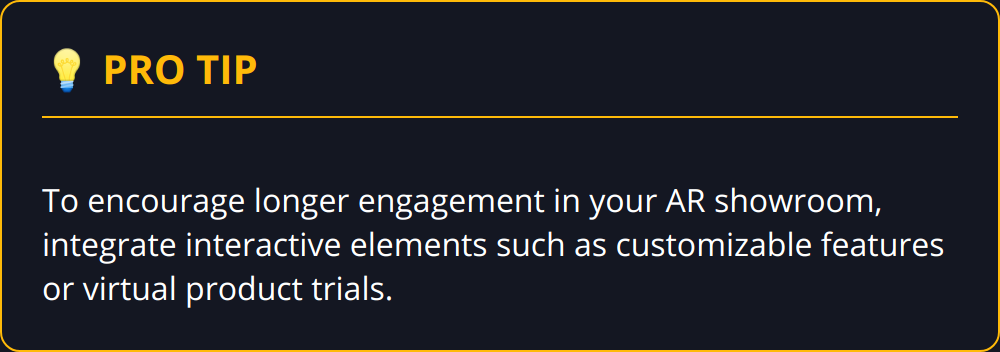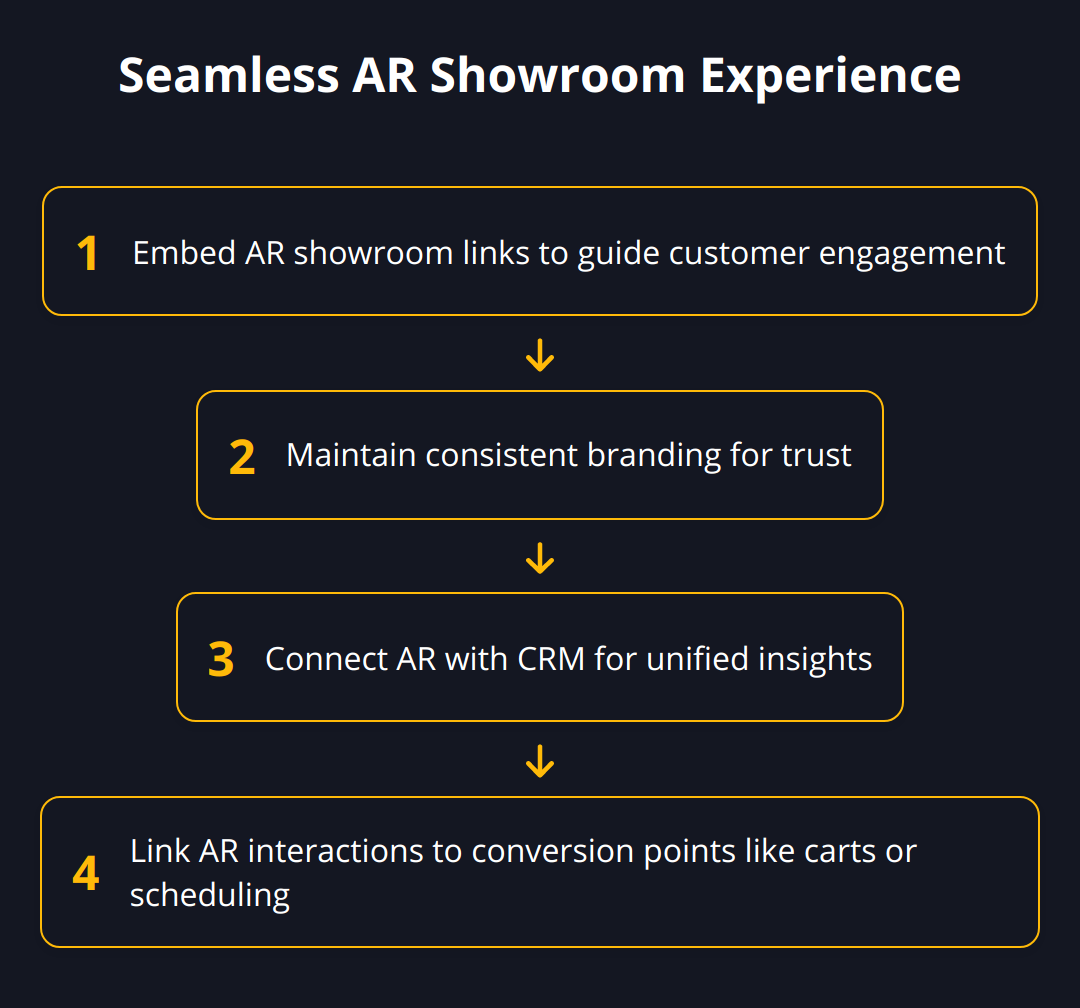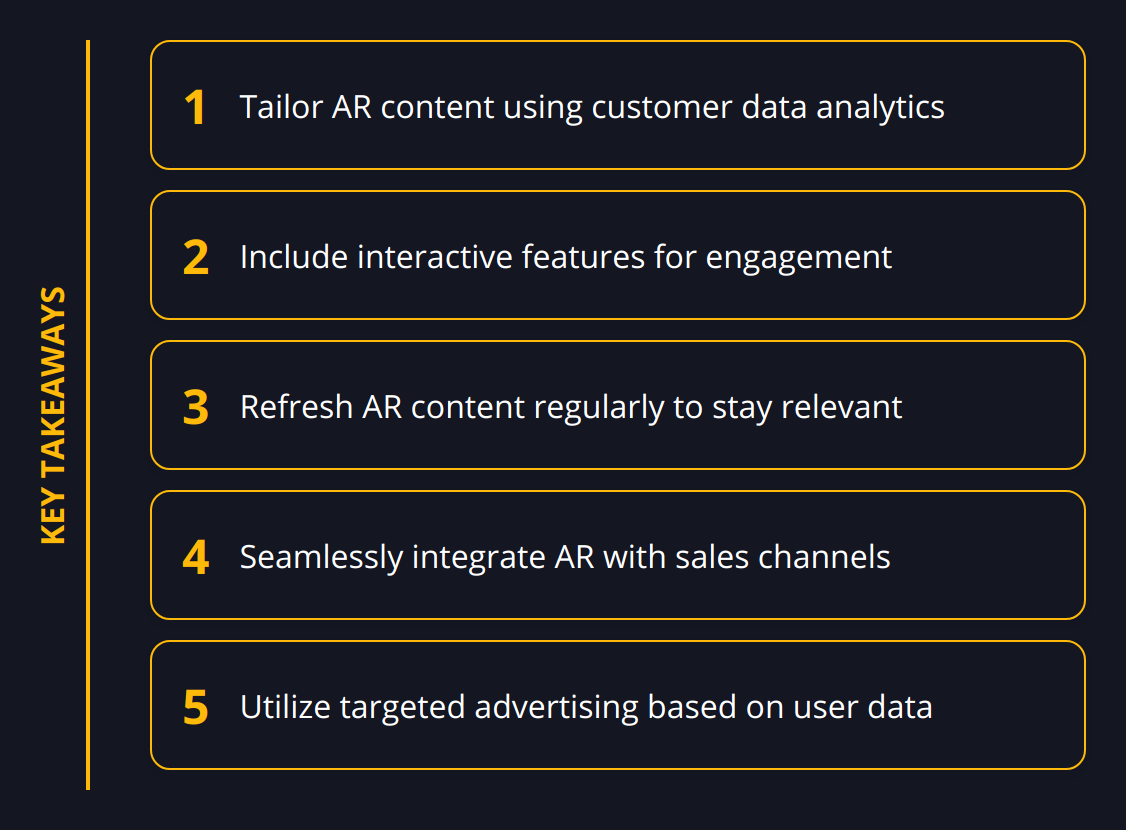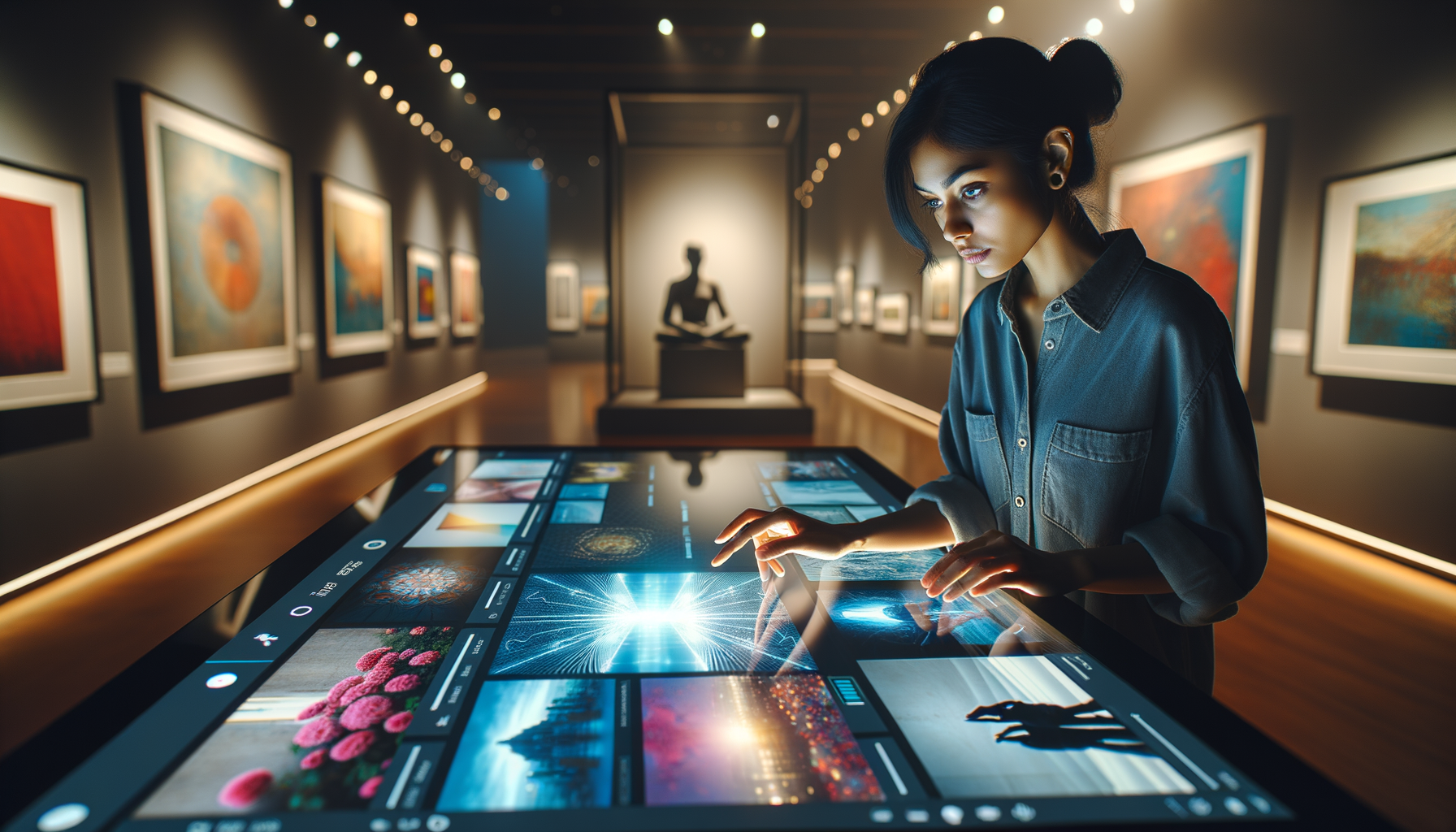We at Newroom Connect believe that the retail landscape is transforming rapidly, with augmented reality (AR) showrooms emerging as a vital tool for brands looking to enhance customer engagement. Designing an AR showroom that captivates and converts requires a deep understanding of your audience, seamless integration with sales channels, and strategic promotion.
In the following sections, we will detail the best practices to create an immersive AR experience that not only attracts but also retains customer interest, ultimately boosting your sales and ensuring your business stays ahead in the competitive market. Join us as we explore the practical steps and strategies to excel with AR showrooms.
How to Engage Customers in AR Showrooms?
Engaging customers in augmented reality (AR) showrooms isn’t just about using new technology for its own sake; it’s about creating experiences that resonate with your audience and give them new ways to interact with your products. To make an AR showroom that stands out, businesses must design with the customer at the forefront.
Tailor Your Experience to Customer Preferences
Start by gathering data on your customers’ shopping behaviors, interests, and pain points. Modern consumers value personalized experiences; therefore, use data analytics to tailor your AR content. For example, if you’re in the furniture business, allow customers to visualize how a couch would look in their specific living space. This personal connection can greatly influence their purchasing decision.

Foster Interactivity with Immersive Demonstrations
Interactive demonstrations are the cornerstone of an effective AR showroom. The inclusion of features like virtual product trials or tours can significantly elevate the user experience. For instance, a virtual car showroom might offer a feature that allows customers to customize vehicle features and see their choices reflected in real-time. Integrating these experiences with simple yet powerful user controls encourages longer engagement times and deeper connections with the product.

Update Content to Maintain Relevance
The digital landscape moves fast, and so should your AR showroom. Regularly refreshed content is vital to keep the showroom experience engaging. An update schedule ensures your showroom reflects current trends, seasonal offers, or new product releases. However, updating content is not purely about keeping things fresh. It also provides insights into what works best for your audience, allowing for data-driven refinements.
It’s crucial to remember that these experiences don’t stand alone—they need to integrate smoothly with your customer’s journey across all platforms. Implementing an AR showroom should be a component of a broader omnichannel strategy to provide a seamless and comprehensive brand experience.
To further enhance your understanding of the topic, consider exploring practical examples in the blog posts “Virtual Showroom Technology” and “Benefits of Digital Showrooms“, which delve into how businesses are successfully leveraging these digital spaces.
In conclusion, by deeply understanding your audience, crafting interactive experiences, and keeping content fresh, businesses can create AR showrooms that not only attract attention but also promote lasting customer relationships and increased sales.
Enhancing Sales with AR Showrooms
Creating a bridge between augmented reality (AR) showrooms and existing sales channels can revolutionize the buying process for your customers. Businesses that seamlessly merge online and offline experiences, provide personalized interactions, and simplify purchasing through AR are poised to see increased success and customer satisfaction.
Seamless Online to Offline Journey
The transition from an online AR experience to an offline purchase should be as smooth as possible. For instance, if a customer designs their ideal car in your virtual showroom, they should be able to seamlessly schedule a test drive at the nearest dealership with the same specifications. Here are practical steps to achieve that:
-
Embed AR showroom links on your website and in targeted marketing emails to drive traffic to the AR experience
-
Use consistent branding and messaging across all platforms to maintain familiarity and trust
-
Connect the AR platform with your CRM system for a unified customer view
-
Directly link the virtual interactions to shopping carts or appointment scheduling systems

Data-Driven Personalization
Incorporate the insights gathered from your AR showroom to personalize the entire sales channel. The data collected can help tailor the customer’s journey and improve the shopping experience. Here’s how to use this to your advantage:
-
Analyze user interactions within the AR showroom to offer relevant suggestions and promotions
-
Use customer data to inform stock availability alerts for items they showed interest in
-
Empower your sales team with information on customer preferences gathered from AR sessions

AR-Driven Simplified Purchasing
One of the powerful aspects of AR showrooms is that they can make complex purchasing decisions straightforward. By visualizing products in their own space, customers can make faster and more confident purchasing choices. Here are strategies to facilitate this:
-
Implement AR visualization tools that link directly to a “Buy Now” option
-
Offer finance calculators within the AR experience for big-ticket items
-
Integrate customer support chatbots within the AR platform to answer questions on the spot
By focusing on these strategies, brands can not only enhance the customer experience but also streamline the path to purchase. The goal is to make the immersive world of your AR showroom a central part of the customer’s journey, providing value at every step.
If you’re exploring how to incorporate these practices into your business, the insights in Virtual Trade Fair Marketing Strategies can be particularly relevant, even though it targets a different digital experience. While the context is distinct, the principles of integration, personalization, and simplification are universally applicable.
Remember, the power of AR lies in its ability to connect and enhance rather than to stand apart as a novelty. Integrating AR with your sales channels should create a harmonious ecosystem that not only delights customers but also drives measurable business outcomes.
Maximizing AR Showroom Visibility
Promotion is the link between the dazzling potential of augmented reality showrooms and the realization of their business value. It is vital to develop a robust strategy to get your AR showroom the visibility it requires. Crafting a campaign that resonates with your target audience and capitalizes on the interactive features of AR will help attract a bigger audience and create a buzz around your digital space.
Firstly, engaging potential customers where they spend their time is fundamental. Social media is a goldmine for interaction. Over 54% of social browsers use these platforms to research products. A well-crafted campaign showcasing the immersive experience of your AR showroom can create intrigue. Share teaser videos of the AR experience, success stories from satisfied customers, or behind-the-scenes looks at the creation process. These draw in audiences and drive up engagement rates. Consider leveraging popular platforms’ native AR capabilities too—such as Instagram filters—to give a taste of the showroom environment.
Secondly, nothing beats the power of immersion at live events. AR at trade shows is no longer a futuristic concept—it’s a present-day expectation. Positioning your showroom features at industry events allows for an interactive handson experience. It’s not only about showing what your AR showroom can do; it’s about letting people experience it firsthand. A successful demonstration at such an event can lead to instantaneous sharing on social media, further amplifying reach. Use immersive kiosks or even AR-enabled business cards to drive interest in your showroom and encourage visits.
Lastly, targeted advertising is not just smart—it’s imperative. With 72% of people claiming to have seen AR ads, the scope for precisely targeted ad campaigns is extensive. Deploying ads across various platforms—such as Google, LinkedIn, or industry-specific websites—permits reaching the specific segment of the market that is most likely to engage with your AR showroom. Harnessing user data can help in creating personalized ad content that appeals to individual buyer’s needs and preferences.

Remember these key points to promote your AR showroom effectively:
-
Use social media strategically—share interactive content and leverage platform-specific AR features.
-
Showcase AR at industry events—create immersive experiences that attendees can’t help but share.
-
Invest in targeted advertising—personalize ad content based on user data for maximum impact.
For further insights and guidance on how to create engaging content for promotion, dive into the comprehensive strategies found in the Virtual Exhibition Benefits & Pro Tips.
In essence, promotion of your AR showroom should be as innovative as the technology itself. Engage, immerse, and personalize—these are the pillars of a successful promotional strategy to take your AR showroom from a hidden gem to a must-see destination.
Measuring AR Showroom Success
Evaluating the success of your augmented reality (AR) showroom is essential for understanding its impact on your business objectives. The return on investment (ROI) stems not just from the financial perspective but also from the value added to the customer experience.
Gauging Customer Engagement
Observing customer engagement with your AR showroom gives you a window into its effectiveness. Key engagement metrics include time spent in the showroom, number of return visits, and interaction hotspots within the AR environment. Tools such as heat maps can visually display where customers are focusing their attention and for how long.
Sales Comparison Insights
A cogent indicator of success is the change in sales performance. Analyze sales data from before and after the implementation of your AR showroom. It’s about looking for uptrends in direct sales attributed to the AR experience. Pinpointing correlations between interaction with AR features and completed purchases is paramount. You should consider seasonal fluctuations or market trends that may independently affect sales, to ensure you are attributing changes correctly to the AR implementation.
Continuous Improvement through Feedback
Your customers’ perceptions of their AR experience can provide invaluable insights. Regularly solicit feedback through surveys or direct interactions, and pay particular attention to suggestions for improvement. It’s not just praise that defines success but also constructive criticism that enables ongoing optimization.
A bullet point summary of practical tips could serve as a succinct takeaway:
-
Track engagement patterns with heat maps and usage statistics.
-
Compare sales data before and after AR showroom launch, adjusting for market trends or seasonal changes.
-
Act on customer feedback to refine and enhance the AR experience.
For a deeper dive into customer feedback analysis, the blog post Analyzing Attendee Feedback for Virtual Trade Fairs offers further exploration into gathering and utilizing customer insights.
Remember that the data you gather should inform your strategy moving forward. If the numbers show an increase in customer satisfaction and sales, then your AR showroom is likely on the right track. If not, it’s an opportunity to identify gaps and strategize accordingly. Measuring the ROI of your AR showroom involves a balance of quantitative data and qualitative feedback that together tell the story of your virtual space’s success.
Wrapping Up
Augmented reality showrooms are more than just a technological novelty; they represent a significant shift in the retail experience. We’ve explored the necessary steps and strategies that businesses must take to create immersive, engaging AR showrooms that resonate with customers and drive sales. Here’s a quick recap of the best practices that can help your business thrive in this innovative space:

-
Personalize the experience to your customer’s needs, which increases their connection to your products and enhances the likelihood of a purchase.
-
Encourage interactivity by integrating immersive demonstrations and user-friendly features that deepen customer engagement.
-
Keep your content updated to maintain relevancy and reflect the latest trends and products.
-
Merge AR seamlessly with your sales channels to create a unified customer journey from online to offline.
-
Utilize customer data to tailor the entire sales experience, making it as personal and effective as possible.
-
Simplify the purchasing process within the AR environment to facilitate quick and confident customer decisions.
-
Promote your AR showroom where your customers are, especially on social media and at live events, to generate interest and drive traffic.
-
Employ targeted advertising to reach the right audience with personalized content.
-
Measure your success through engagement metrics, sales data, and customer feedback, using these insights to continuously improve the AR experience.
The impact of a well-executed AR showroom on customer experience and sales can be transformative. Providing customers with an engaging, personalized journey through AR technologies not only builds brand loyalty but also sets the stage for increased conversions.
In an ever-competitive market, AR showrooms represent a powerful opportunity for businesses to distinguish themselves. Those who adopt these technologies are positioned as leaders and innovators, appealing to a modern consumer base that values immersive and convenient shopping experiences.
We at Newroom Connect help businesses like yours craft these unforgettable digital spaces. Whether you’re looking to develop virtual trade fairs, virtual showrooms, or e-learning platforms, our solutions can bring your vision to life. By embracing AR showrooms, your business does not just keep pace with the competition—it sets the pace.
In conclusion, adopting AR is not merely an option—it’s a decisive move to elevate your brand. Engage with us at Newroom Connect, and together, let’s shape the future of retail and learning by harnessing the boundless possibilities of AR.


